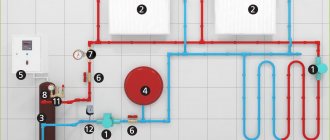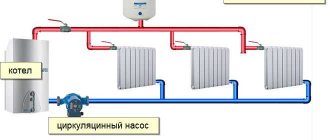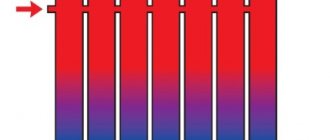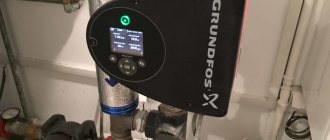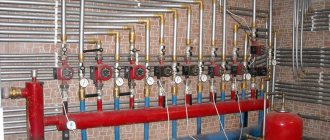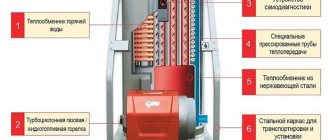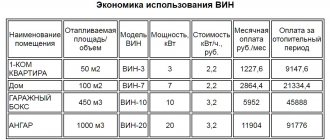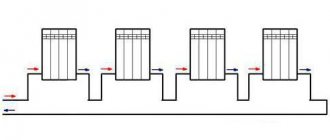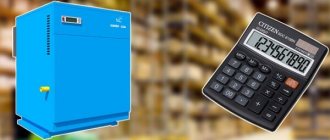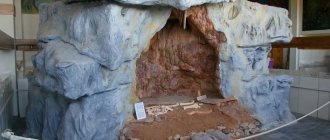Today is the time of high technology not only in IT, but also in the field of boiler equipment. An electric boiler with a pump is a new technical solution for autonomous heating in the Smart Home system to increase the efficiency of heat supply, create comfortable living conditions and safety during operation. This direction has many energy-saving connection options and the ability to integrate green energy elements into the circuit - wind generators and solar collectors. The feasibility of using an electric heating and hot water supply scheme will largely depend on the correct choice of equipment and its wiring, so the user needs to know all the pitfalls of this direction.
Design features and operating principle
An electric boiler (EC) with a pump is a source of hot coolant for heating and hot water supply. A typical piping scheme contains: a pump, an expansion tank, a control and safety unit, shut-off and control valves. The latest modifications of boilers successfully combine all the elements of the circuit in one housing.
This arrangement of an electric boiler with a pump not only simplifies installation and maintenance, but also creates a modern look for the unit that can successfully fit into the interior of any room. An important fact of this arrangement is energy efficiency, since all working elements are insulated in the housing, which reduces heat losses of the installation and increases overall efficiency.
Despite the fact that such a scheme must have an expansion tank to drain excess coolant that expands when the water is heated, not all boiler models are equipped with such a device, so the buyer should pay attention to this condition when purchasing an electric boiler in a retail chain.
The circulation pump is a mandatory element of the forced circulation circuit in double-circuit electric boilers. It solves two problems:
- Circulation of network water in the heating circuit;
- alternating inclusion of coolant through heating and hot water circuits in dual-circuit systems. When the user opens the tap, the coolant flows through the hot water boiler; when the tap is closed, it flows through the heating system.
There is one caveat at this point: the manufacturer equips the EC with a pump of appropriate power, taking into account the average value of the hydraulic resistance of the system, which does not always reflect the real losses in consumer networks. Especially in the case of diversity of heating objects and ramifications of the heating network. This will lead to the fact that the pump simply will not “pull” the user’s system, and it will not work even with the most expensive and modern heater. In order to avoid this negative situation, the purchase of an EC with a pump begins with the calculation of the thermal heating circuit, for which you need to contact specialists.
What does an electric boiler with a pump look like?
The operating principle of an electric boiler is that heat is generated from electricity in heating elements or induction elements with high ohmic resistance. The cold coolant enters the EC using a pump on the return pipeline, uniformly washes the heating elements, and therefore quickly increases its temperature and exits the boiler into the heating and hot water circuit.
In order for the system to work, a special input is made in the circuit with pressure protection of no more than 3 bar and the installation of a check valve. The heating process is controlled using a thermostat. When the coolant reaches the operating temperature, the sensor turns off the power to the heating elements, and if it drops, it supplies current to the heating elements.
Heating scheme with electric and solid fuel boiler
Most often, electric boilers for water heating at home are installed as an additional heating source in tandem with a solid fuel heater. In one of the articles we said that the design of a solid fuel boiler may have design differences. So, there are conventional devices and long-burning ones. In both cases, you need to add firewood, coal, etc. to the firebox from time to time. Accordingly, the owner ends up tied to the house, but what if he needs to leave for a couple of days? This is where an electric heater comes in handy.
In the heating circuit of an electric boiler with a heat transfer heater, the connection is made in parallel. In this case, each circulation ring must be equipped with:
- electric pump;
- check valve.
Only in this case everything will work like clockwork. In this case, the method of pipe routing does not matter; the principle of connecting two heaters is the same. Naturally, you need to set up automation and synchronize the operation of pumps and heaters. Both boilers must be connected to their pump without interfering with each other. The principle is that if the heater stops, the pump synchronized with it should also not work and vice versa.
Advantages and disadvantages
Based on experience in operating different types of boilers for individual heat supply, experts rightly believe that the most convenient to operate is an electric boiler with a circulation pump.
Advantages of connecting electric boilers with a pump:
- Full integration of pump operation with thermal circuit elements.
- Low specific indicators for own energy consumption for the implementation of the assigned tasks; they have virtually no effect on the overall heating costs.
- The highest efficiency among other heating sources up to 99%.
- 100% automation of technological processes.
- Environmentally friendly – no harmful emissions into the atmosphere.
- Low specific coefficients of material consumption, there is no need to install expensive equipment on the chimney, create draft in the boiler and organize air supply to the combustion chamber.
In fairness, it should be noted that the system has one very significant drawback - the high cost of electricity for heat generation technology. There are several options to reduce energy costs:
- Effective thermal insulation of a heating facility.
- The use of combined heat production with the inclusion of secondary energy sources in the scheme: solar, wind, water heat pumps.
- Transition to multi-tariff electricity metering with the inclusion in the heat supply scheme of a storage tank for heating water during the period of the preferential tariff.
Materials used
Materials for the piping circuit of an electric boiler must ensure safe operation of the equipment and comply with the requirements of state regulations and standards for operation, rules for the technical and safe operation of consumer electrical installations.
Requirements for piping electric heating boilers:
- The power supply is carried out by a copper wire with a cross-section indicated in the passport;
- grounding must be carried out in accordance with the requirements of the PUE, and checked annually for operability;
- a separate cable with an automatic safety switch must be installed;
- It is prohibited to use gas, water and sewerage systems as a grounding loop.
Before choosing a material for piping an electric boiler, you need to familiarize yourself with its technical capabilities, which affect the operation of electric heating. For pipes, important characteristics are thermal insulation properties, the ability to create complex structures and the cost of piping. The most common piping solutions are polypropylene or copper pipes.
Copper piping
Carrying out installation using copper pipes requires certain experience from the performers, and significant financial resources from the users. Advantages of copper pipes:
- High heat transfer coefficient of copper - heating of the room is carried out not only by heating devices, but also by the piping system.
- High anti-corrosion protection, although pipes become covered with a thin layer of corrosion over time, it does not affect performance.
- There is no threat of rupture of the pipeline system from freezing. This is due to the fact that copper is more ductile and can withstand freezing loads without compromising its integrity.
Piping an electric boiler with copper pipes
- High installation cost;
- Copper pipes should not be buried in the wall;
- the need for high-quality insulation;
- protection against stray currents, the effect of which is detrimental to copper.
Tying with polypropylene pipes
Many users consider polypropylene to be an ideal option for EC strapping. This pipe option is reinforced with fiberglass reinforcement to resist heat. The smooth, anti-corrosion inner surface of the pipes ensures excellent circulation speed of heating water. Installation technology using special welding equipment ensures high quality work without coolant leaks. When preparing a thermal heating scheme and dividing it into heating sections, you should take into account the features of plastic - a high coefficient of expansion and heat loss. Therefore, it is not recommended to choose areas with a long length of pipes.
Polypropylene pipes are connected in 2 ways: soldering and using fittings. The first method is the most reliable, practically does not allow leaks, the second is less reliable, even with a slight displacement - hot water begins to leak.
Modern polypropylene pipes are distinguished by long service life - 40 years or more and high strength, able to easily withstand environmental pressure up to 25 Bar. The latest modifications of these pipes have received protection against excessive expansion; today, even heating the coolant to 95 C does not cause deformation.
Criterias of choice
The choice of equipment depends on several factors, but the basic one is the thermal power of the facility. An accurate calculation can only be performed by a specialized organization. But for an approximate calculation, a simple ratio of power and heating area is used for central regions, for example, in Moscow: for 10 m2 - the required power is 1 kW.
The next criterion is the connection diagram, which depends on the possibility of subscriber input of the electrical network into the house, voltage and number of phases. For a small boiler of 6 kW (object up to 60 m2), you can connect to a single-phase 220V network, while larger power boilers will require three-phase networks (380 V). Many manufacturers produce units with the ability to connect to both three-phase and single-phase networks.
When choosing an electric boiler with a pump, you need to take into account the thermal power
The next factor is that the security system must cope with threats such as low or high pressure of network water, overheating of the heating element or freezing of water. EC control is selected from three options: manual, digital or programmable. It is advisable to choose a unit with power control. In budget models it is stepped, and in devices with programmers it is smooth.
In this case, based on data from pressure and temperature sensors, the software allows you to automatically set the mode. When using a multi-tariff meter, the maximum load on the boiler will operate from 23:00 to 07:00. Of no small importance is the presence of auxiliary devices complete with the pump and expansion tank: temperature and pressure sensors, fittings and pressure gauges.
Electrode boilers
Ionic boilers are another name for these boilers. The principle of their operation is to use a coolant that has electrical conductivity. Electrodes to which a voltage of 50 Hz is applied are integral structural elements of such a device. A two-phase or three-phase AC network ensures the operation of such heaters. The three-phase version is used for devices of higher power and increased dimensions.
The housing is grounded and plays the role of one electrode. Reliable grounding is an indispensable condition for safe operation of the boiler. Grounding is expensive.
The second electrode is a metal rod. It is placed in a container where the electrolyte circulates.
After connecting the alternating voltage, the coolant molecules begin to move chaotically and collide. The released energy heats the electrolyte. It is then distributed among the heating devices and, having transferred heat, again enters the heating zone.
In Table 1, the lower limits of specific power parameters refer to small units. The lower limits of the unit cost, on the contrary, apply to powerful devices. The data is provided without taking into account the costs of automatic control systems, which significantly save electricity.
| Parameter | Meaning |
| Length | up to 60 cm |
| Diameter | up to 32 cm |
| Power | 2-50 kW |
| Optimal temperature | 75 C |
| Specific power | 0.35 + 0.5 kW/kg |
| Unit cost | 0.28 + 2 thousand rubles/kW |
When heating, the boiler power increases due to a decrease in the resistance of the electrolyte as its temperature increases. Continued heating requires more and more power. The temperature of the liquid is therefore limited by design. The maximum permissible value is determined by the properties of the liquids and the parameters of the boilers. Low temperatures of the heat transfer fluid compared to the norms for heating radiators (for example, 50ºC for boilers versus 90ºC for aluminum radiators) increase the radiator area. The costs associated with this are the fee for using the electrode boiler.
Working processes in electrode boilers cause changes in the properties of the coolant. It has to be changed in a timely manner so that power consumption does not increase. This is another cost item.
Stray currents appearing in electrode boilers cause electrochemical corrosion of structural elements even made of stainless steel. The gradual dissolution of the electrode rod adds to the worries. Increased operating costs are a consequence of these circumstances.
Electrode boilers are easy to operate, very reliable, take up little space, do not make noise, are equipped with advanced automation devices, have a wide power range, and are safe to operate. Choosing an electrode boiler is the best solution for those who need to quickly heat up a residential building (for example, when visiting their country house in winter). This is a champion in terms of heating speed. These boilers can be assembled in cascades, increasing the total power to the required limits.
Electrode boilers are innovative products. They are produced by venture producers. Well-known companies prefer heating elements.
Equipment power calculation
After the thermal circuit has been calculated, the number of circuits, the length of the network has been established, and a point for placing the source has been selected, we begin to select the EC parameters. In the retail network they are sold with a power from 2 to 70 kW, and devices with a thermal performance of more than 50 kW are used for industrial facilities.
Power calculations are entrusted to a special organization, they use online calculators or are calculated using the formula: Wк=(SxWsp)/10, where:
Wк – thermal power of the unit, kW; S – total heated area, m2; Wsp – specific power per 1 m2 of area, depends on the climatic region, set: for the southern regions 1.0, for the central ones – 1.1 – 1.15, for the northern ones – 1.2.
Calculation example: Climatic region – center of Russia. Heating area – 160 m2. Thermal power: (160∙1.1)/10=17.6≈18 kW.
This calculation is quite suitable for a single-circuit heat supply scheme, that is, only for heating. In double-circuit schemes with hot water supply, it will be necessary to carry out additional calculations for the needs of hot water supply, taking into account SNIP standards for hot water consumption and the number of service users.
The next calculation that will be required in electric heating is the calculation of the electrical network for connecting the unit. An incorrectly selected cable will overheat greatly during operation, creating a fire hazard. For an approximate calculation, you can take a simple ratio - a current of 1 A will require a cross section of 1 mm2. Calculation example for determining the cross-sectional area of an electric boiler cable:
Power – 6 kW; The network is single-phase 220V. Calculation formula for conductor cross-sectional area mm2: S= Wк/(U∙I). U – 220 V, I – 8 A. Calculation: S= 6000/(8∙220)=3.41 mm2
This is a fairly approximate calculation; you will also need to take into account the cable material and its length.
All work on the installation of electrical equipment must be carried out in full compliance with the requirements of industry norms and standards, as well as safety rules:
- It is prohibited to install the unit in close proximity to a water supply or water source.
- During installation, observe the recommended construction distances between the unit and structures.
- A mandatory connection of the EC to the ground loop is required.
- The wall-mounted device is installed on a wall made of non-combustible materials.
- Laying power cables under heating or water pipes is prohibited. In places where utility networks may intersect, a protective metal casing is installed.
An electric boiler with a pump must be installed in full compliance with all safety regulations
Installation nuances
First of all, it should be said that there are two types of systems with an electric heat generator:
- With natural pressure on the coolant (the electric boiler is located at the bottom of the circuit).
- With forced circulation (you can find a video with a detailed analysis of pump installation on the website). The boiler can be located at any point in the chain (except for the highest).
Many private home owners install not one, but two electric boilers. "just in case". If the backup device does not operate at full capacity, then the electric boiler is installed in parallel, so that both generators work with the same power.
